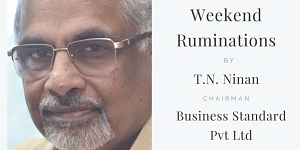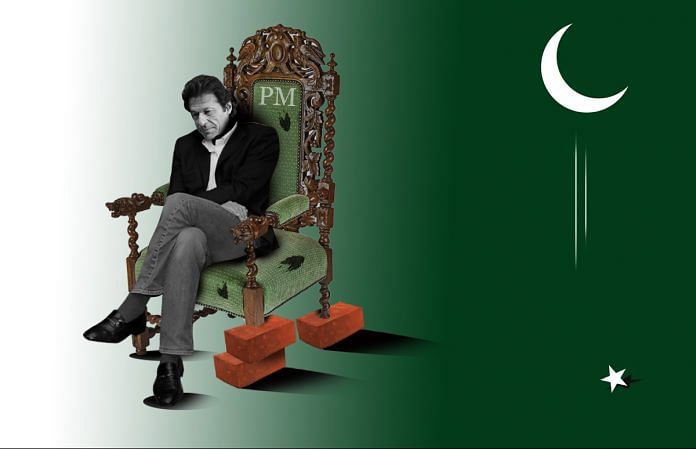There’s an intriguing prospect of Imran Khan & Asad Umar attempting a Narasimha Rao-Manmohan Singh act to rescue Pakistan’s economy.
The press coverage of the post-election situation in Pakistan has shifted slowly from the initial focus on Imran Khan’s links with the army, and a Khan government’s likely policy vis-à-vis India, to the country’s dire economic situation. The last two are linked, but more on that in a moment.
 Pakistan’s foreign exchange reserves have dipped sharply this past year, while the current account deficit has soared and bulk loan repayments loom over the horizon. The Pakistani rupee has taken a tumble, even as the central bank has jacked up interest rates sharply, by 100 basis points last month, following an increase in May. Economic growth is certain to dip after a six-year acceleration that saw it peak at 5.6 per cent. A loan application to the International Monetary Fund (IMF) seems unavoidable.
Pakistan’s foreign exchange reserves have dipped sharply this past year, while the current account deficit has soared and bulk loan repayments loom over the horizon. The Pakistani rupee has taken a tumble, even as the central bank has jacked up interest rates sharply, by 100 basis points last month, following an increase in May. Economic growth is certain to dip after a six-year acceleration that saw it peak at 5.6 per cent. A loan application to the International Monetary Fund (IMF) seems unavoidable.
That raises the interesting prospect of a US vs China play-off. China has become Pakistan’s biggest international funder, accounting for 38 per cent of foreign money taken in by Islamabad in fiscal 2017 (ended June); no data is available as yet for fiscal 2018. Meanwhile, the US is the largest shareholder in the IMF with one-sixth of the vote, and has said that it will oppose IMF money being used by Pakistan to repay Chinese loans. That does not mean a loan will not be approved, but Pakistan will have to win the support of other major economies.
Also read: Those who vote for Imran Khan or Narendra Modi shouldn’t be dismissed as bigots or sexist
Whether or not a loan is approved, Pakistan will have to course correct. Under a novice prime minister who has no taste for detail, the real burden of reform will fall on the shoulders of the finance minister, who is widely expected to be Asad Umar, a business executive-turned-politician. That raises the intriguing prospect of Khan and Umar attempting a Narasimha Rao-Manmohan Singh act, i.e. launching on a wide-ranging reform agenda in the middle of a foreign exchange crisis.
Umar stepped into the limelight many years ago for enjoying the highest salary in Pakistan when he was chief executive of the Engro conglomerate. He stepped down from that role when he was 50 to join politics, and has been a member of parliament since, representing Khan’s Pakistan Tehreek-e-Insaf (PTI). He presumably authored the PTI’s manifesto promise of lowering corporate taxes (currently 31 per cent), and distancing the government from all public sector undertakings by placing them in something like a wealth fund, to be independently managed.
A reform agenda that enthuses investors and lenders might well stanch the dollar outflow and restore financial stability. But it would also mean dumping Khan’s election promise of a costly welfare programme, and sharp cutbacks in spending — for which there is little room. Defence spending accounts for by far the largest chunk of expenditure after interest payments, and is eight times the money spent by the federal government on health and education. Will the generals in Rawalpindi agree to tighten their belts after their horse has won the race?
In a best-case scenario, the Khan-Umar duo might rescue the economy from its cycle of repeated crises and IMF bail-outs (the last one was just five years ago). The mini-miracle that Rao-Singh pulled off in India is not on offer in Pakistan, for straightforward reasons. Pakistan’s savings and investment rates as a share of gross domestic product are half what they are in India, so economic growth cannot possibly match what India has managed to achieve. The tax-to-GDP ratio is barely two-thirds of India’s today, so the government’s capacity to spend is limited. Exports fell for three years before recovering last year, but competitiveness will not return without the Pak rupee falling further from the current 123 to the dollar.
In the end, it will boil down to Khan’s India policy. The logical thing for him to do is sue for peace with India, cut defence spending, and use the resulting peace dividend to re-build his country’s economy. Unfortunately for Pakistan, the odds on that happening are not worth betting on.
By Special Arrangement with Business Standard.
Also read: Imran Khan’s Naya Pakistan already has the ‘purana’ Pakistan solidly embedded







Some of the concluding advice would be valuable for India as well. All of South Asia could do with a peace dividend, benefit from greater regional integration, with life and relevance being breathed into SAARC. Three young girls starving to death in Delhi recently should resonate as much with us as the prospect of foreign military bases or a permanent seat on the UNSC.